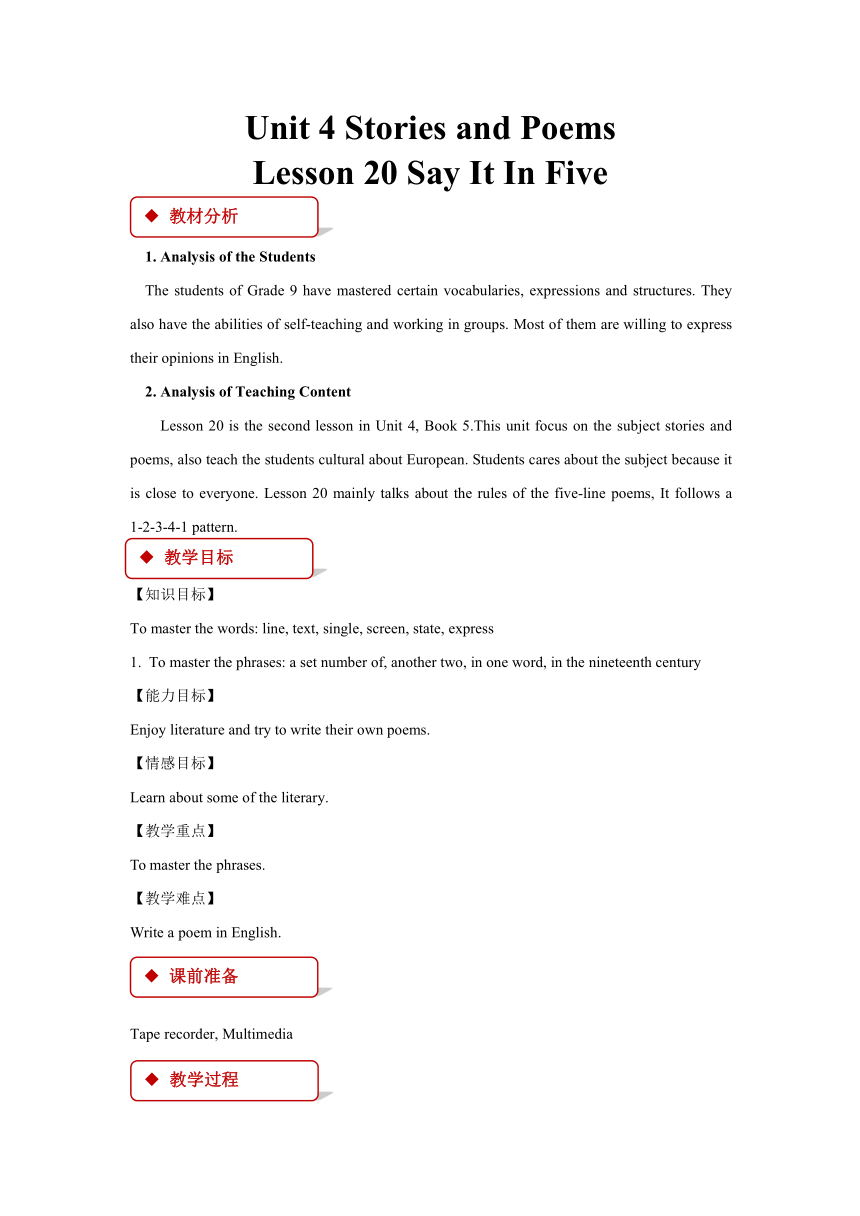
Unit 4 Stories and Poems Lesson 20 Say It In Five 1. Analysis of the Students The students of Grade ( http: / / www.21cnjy.com" \o "欢迎登陆21世纪教育网 ) 9 have mastered certain vocabularies, expressions and structures. They also have the abilities of self-teaching and working in groups. Most of them are willing to express their opinions in English. 2. Analysis of Teaching Content Lesson 20 is the second lesson in Unit 4, Book 5.This unit focus on the subject stories and poems, also teach the students cultural about European. Students cares about the subject because it is close to everyone. Lesson 20 mainly talks about the rules of the five-line poems, It follows a 1-2-3-4-1 pattern. 【知识目标】 To master the words ( http: / / www.21cnjy.com" \o "欢迎登陆21世纪教育网 ): line, text, single, screen, state, express To master the phrases: a set number of, another two, in one word, in the nineteenth century 【能力目标】 Enjoy literature and try to write their own poems. 【情感目标】 Learn about some of the literary. 【教学重点】 To master the phrases. 【教学难点】 Write a poem in English. Tape recorder, Multimedia Step 1. Warm-up 1. Free talk: Teacher show two pictures of poems in Chinese, and ask students: Do Chinese old poems follow a pattern Show a poem “Brother” in English to elicit five-line poem. Then answer the questions: How many lines Translate the poem. Step 2. Presentation Match and complete the format of a five-line poem. By the five-line poem below. Check the answers. Enjoy and read the five-line poems on page 52. ( T: How about another poems Let’s see!) Explain the new words. Listen to the passage and answer the questions: Where are five-line poems from What are they about Where is the topic in a five-line poem Check the answers through train game. Explain the language points: in the nineteenth century意为“在19世纪”=in the 1800s。 表示“在某世纪”时,用“in+the+序数词+century”,表示“在某世纪某年代”时,用“in+the+数字+-s/-’s”。 Attention: 用数字表示“某世纪”时,不要丢掉定冠词the。 a number of意为“一些”,与 some或several同义,后面往往接可数名词复数。a number of短语作主语时,谓语动词往往用复数形式。句中的set是过去分词起形容词作用,意为“固定的,规定的”,修饰后面的名词number。 the number of意为“……的数目”,后接名词复数。以the number of短语作主语时,谓语动词使用单数形式。 another two poems意为“另外两首诗”,与two more poems同义,“another+数词+名词复数”相当于“数词+more+名词复数”,表示“再几个……”。 own意为“自己的,属于自己的”,在形容词性物主代词后面加强语气。 常用结构为“one’s own+名词”,意为“某人自己的……”。 a five-line poem意为“一首五行诗”。由“数词+名词”构成的复合形容词,中间用“-”连接,名词不用复数形式。 state为动词,意为“陈述,说明”。常指书面或演讲中的正式表达,其名词形式为statement,意为“陈述”。 topic 表示“主题”。 英语中用不同介词表达“用”:in表示“用语言等”;with表示“用工具、手段、材料等”;by表示“用手段、方式等”。 express意为“表达”,在文中是及物动词,常用于express sth. to sb.结构,意为“向某人 ... ...
~~ 您好,已阅读到文档的结尾了 ~~

